ION expands ETF trading capabilities with Tradeweb integration
Introduction & Market Context
Aurora Innovation (NASDAQ:AUR) has officially transitioned from development to commercial operations, according to its Q1 2025 business review presentation delivered on May 8, 2025. The company announced that its autonomous trucks are now commercially hauling freight without drivers between Dallas and Houston, marking a significant milestone in the autonomous trucking industry.
The presentation comes as Aurora’s stock has shown strong performance, with shares trading at $7.31 at market close on the day of the presentation, representing a 6.02% increase. The company’s stock has traded between $2.10 and $10.77 over the past 52 weeks, indicating significant volatility but overall positive momentum as commercial operations begin.
Operational Highlights
Aurora has successfully closed its Dallas to Houston Safety Case, achieving a 100% Autonomy Readiness Measure (ARM), which enabled the commencement of driverless operations on this route. This achievement represents the culmination of years of development and testing.
As shown in the following chart of quarterly Autonomy Performance Indicator (API) loads, Aurora has demonstrated consistent improvement in performance over time, exceeding its commercial launch target before actual launch:
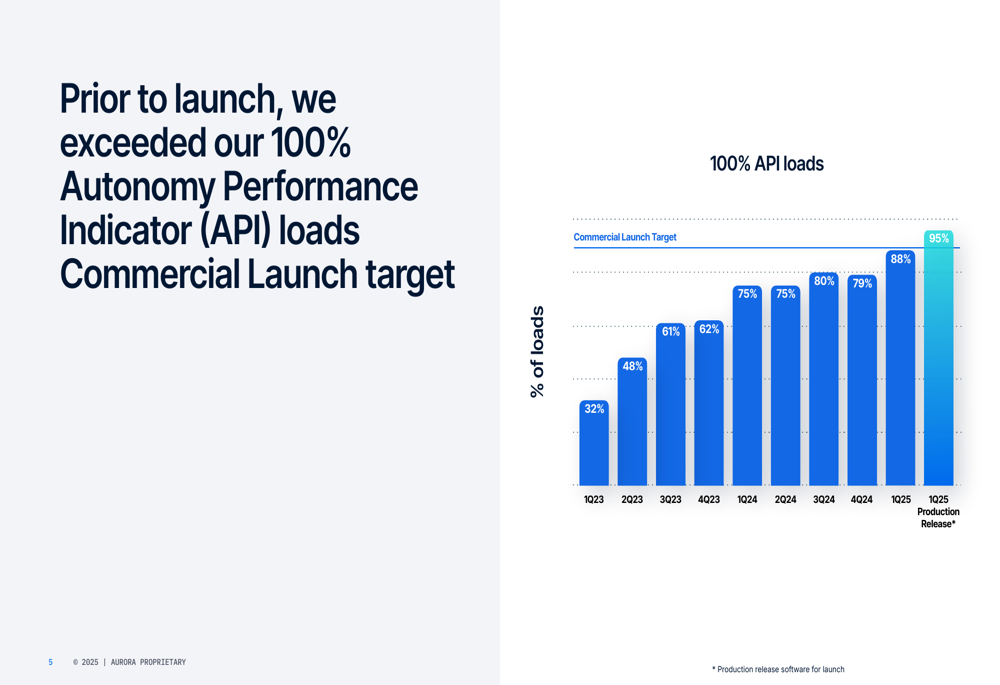
The company has established key partnerships with major logistics providers. Aurora has begun driverless commercial deliveries for Uber (NYSE:UBER) Freight between Dallas and Houston, with Uber Freight’s CEO Lior Ron stating: "Moving autonomous commercial freight without anyone behind the wheel is a historic step forward in our mission to build a smarter and more efficient supply chain, and one we’re proud to lead alongside Aurora."
Similarly, Aurora has launched driverless commercial deliveries for Hirschbach on the same route:

Aurora’s operational metrics demonstrate significant scale even at this early stage of commercial deployment. The company reported completing over 11,000 commercial loads, covering more than 3 million miles, with a nearly 100% on-time delivery rate for Aurora-controlled operations.

Technology and Safety
Aurora emphasized the technological advantages of its autonomous system, highlighting the "superhuman capabilities" of the Aurora Driver. The presentation showcased the system’s ability to handle challenging scenarios including low light conditions, intense sun glare, and complex traffic situations that would challenge human drivers.
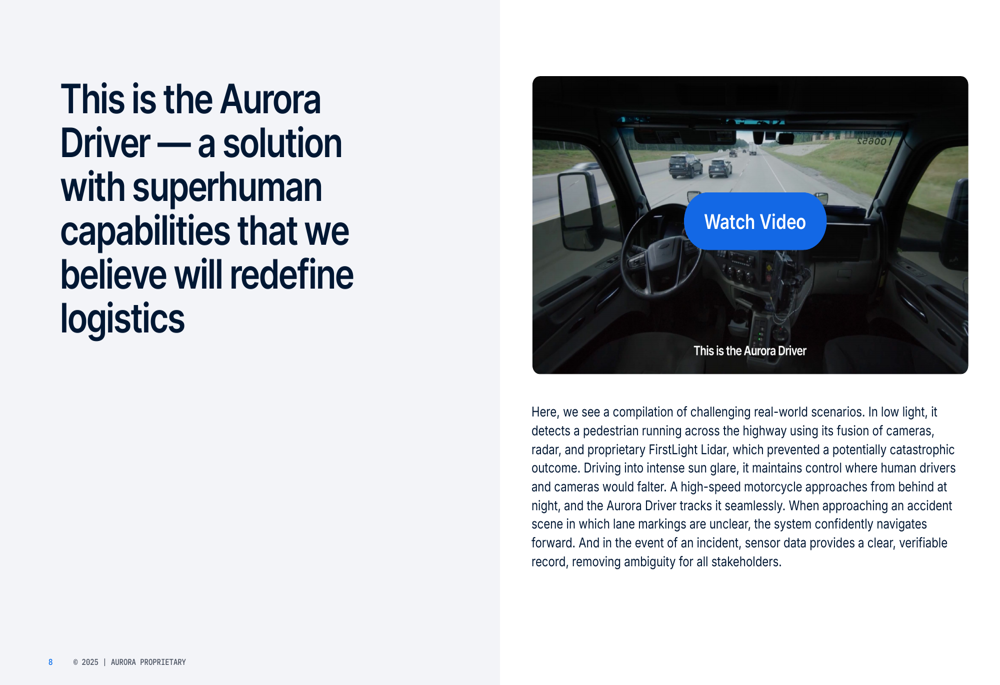
The company’s focus on safety is evident in its methodical approach to commercial deployment. Aurora exceeded its API loads target before launch, with its production release software achieving a 95% API rate in Q1 2025, demonstrating the maturity of the technology before commercial deployment.
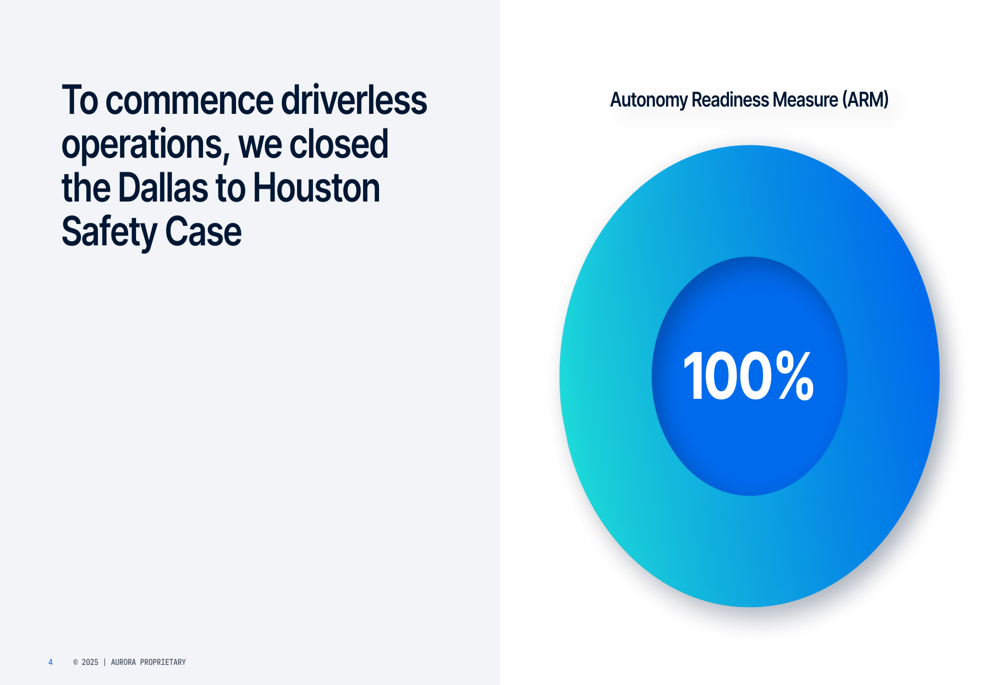
Strategic Roadmap
Aurora outlined a clear product roadmap for 2025, focusing on a "crawl, walk, run" approach to expand capabilities and increase value for customers. Following the commercial launch in Q2 2025, the company plans to add night driving capabilities in Q3 2025, followed by operations in rain and heavy wind conditions by Q4 2025. Geographic expansion is also planned, with the Fort Worth to El Paso to Phoenix corridor targeted for Q4 2025.
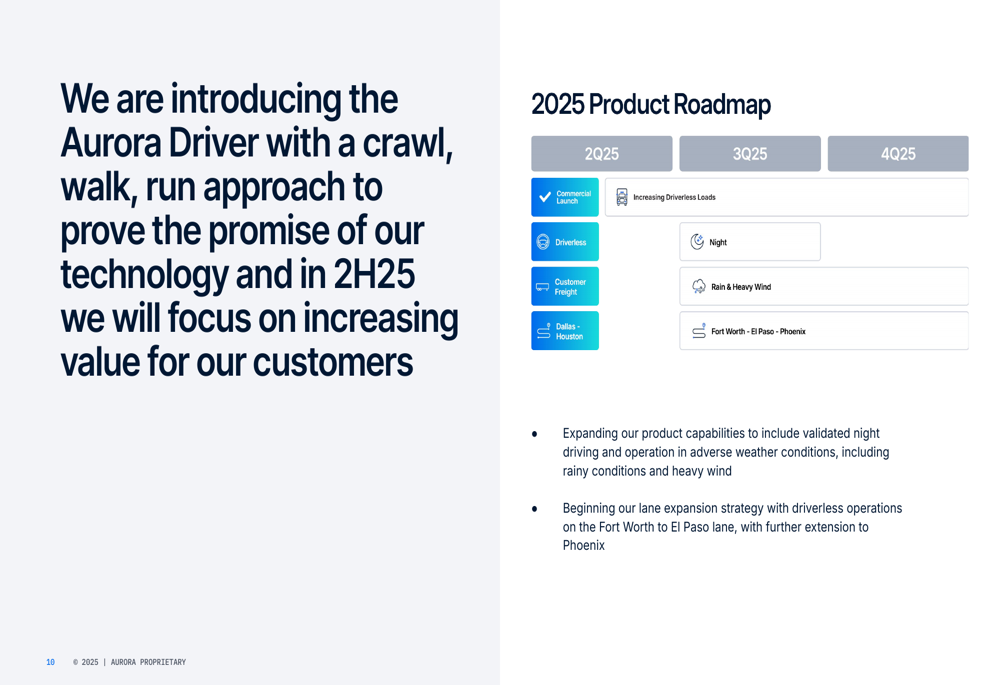
A significant strategic partnership with Werner Enterprises (NASDAQ:WERN) will support this expansion, opening a 1,000+ mile autonomous lane from Fort Worth to Phoenix. This route exceeds the 11-hour federal hours-of-service limitation for traditional drivers, highlighting a key advantage of autonomous trucks that can operate continuously.
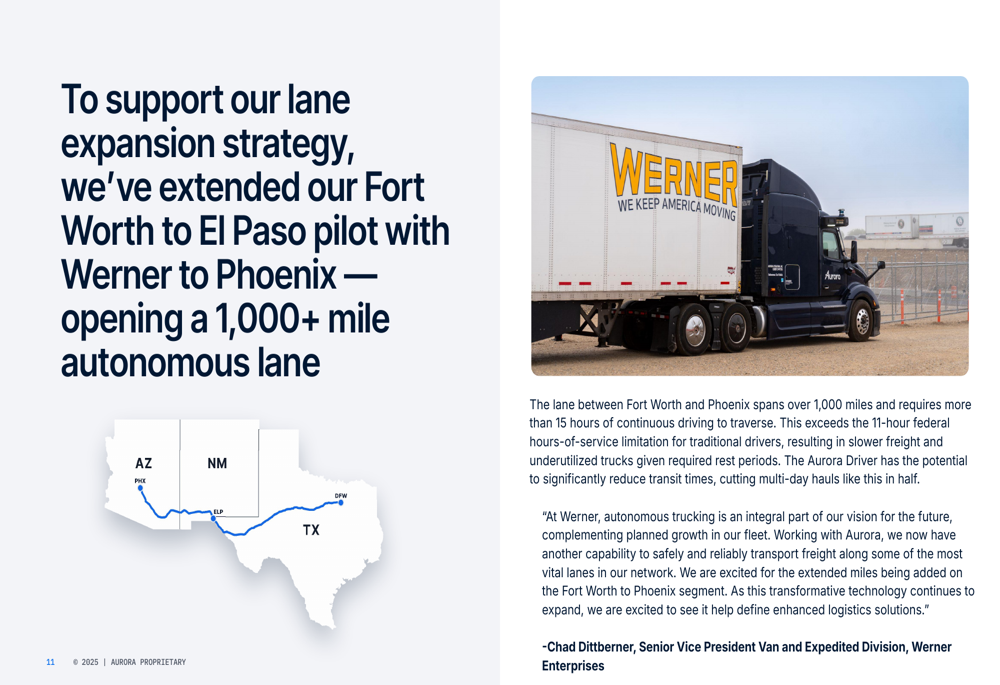
Looking further ahead, Aurora presented its roadmap to scale from 2025 through 2027, outlining the evolution of its business model, product capabilities, and scaling enablers. The company plans to transition from Aurora-owned terminals to customer-owned and blended models, while expanding operational capabilities to include various lanes, trailer types, and weather conditions.
Financial Performance
Aurora reported a solid financial position with $1,159 million in cash and short-term investments as of March 31, 2025. The company’s operating expenses for Q1 2025 totaled $211 million, with research and development accounting for $182 million and selling, general, and administrative expenses at $29 million.
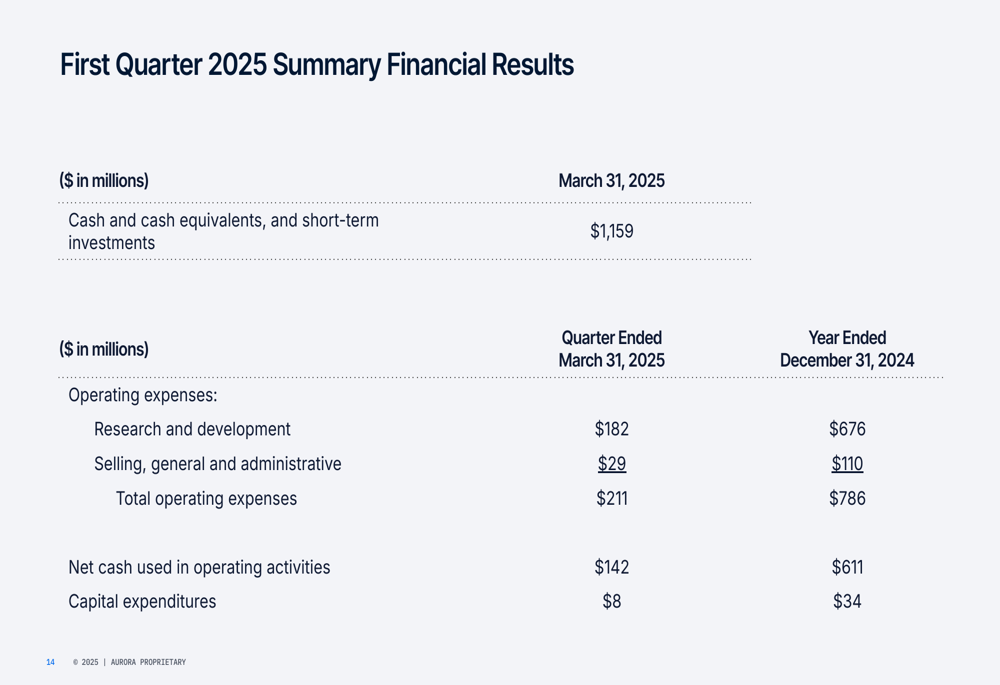
Net cash used in operating activities was $142 million for Q1 2025, compared to $611 million for the full year 2024, indicating a quarterly burn rate consistent with previous guidance. Capital expenditures were relatively modest at $8 million for the quarter.
This financial position appears to align with previous projections. In late 2023, Aurora had indicated it had sufficient cash to fund operations into the second half of 2025, with over $1.3 billion in cash and investments at that time. The current cash position of $1,159 million suggests the company is managing its burn rate while executing on its commercial launch plans.
Forward-Looking Statements
Aurora’s strategic focus is centered on a three-step approach: proving the promise of autonomous technology, increasing the value of its product for customers, and ultimately becoming an essential partner in the freight industry.
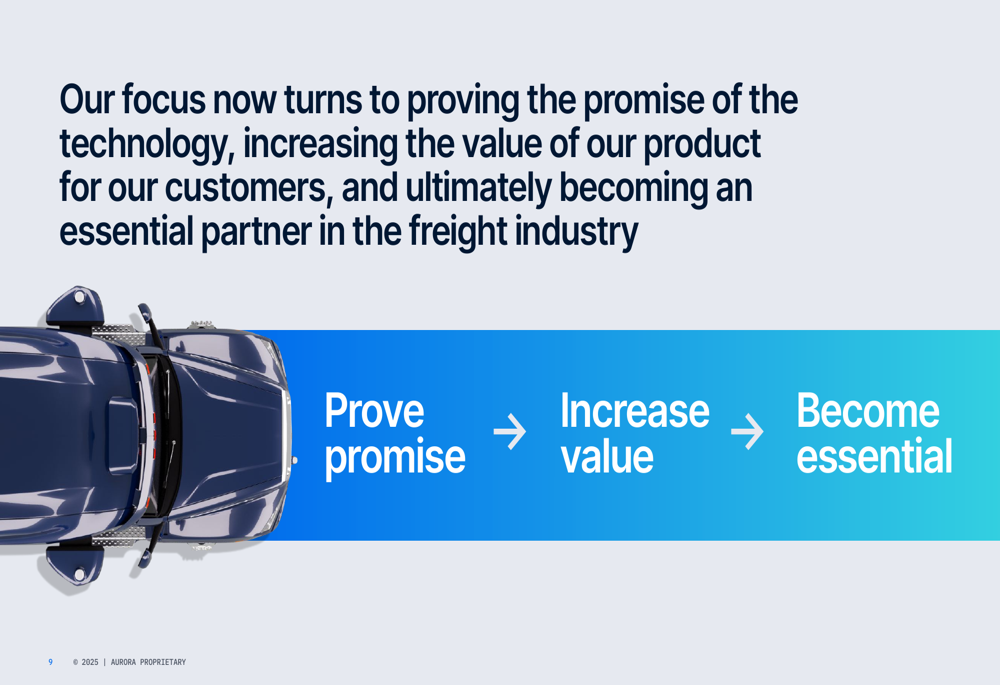
The company’s transition from development to commercial operations represents a critical inflection point in its business model. With driverless operations now underway, Aurora is positioned to begin generating commercial revenue while continuing to expand its operational capabilities and geographic footprint.
The planned expansion to longer routes like Fort Worth to Phoenix could significantly enhance the value proposition of autonomous trucking, as these routes exceed human driver limitations and could potentially cut multi-day hauls in half, according to the company.
As Aurora continues its commercial rollout throughout 2025, investors will be watching closely for evidence of revenue growth, operational efficiency, and progress toward positive cash flow. The company’s strong cash position provides runway to execute its near-term plans, but the path to profitability will depend on successful scaling of operations and customer adoption of autonomous trucking services.
Full presentation:
This article was generated with the support of AI and reviewed by an editor. For more information see our T&C.
